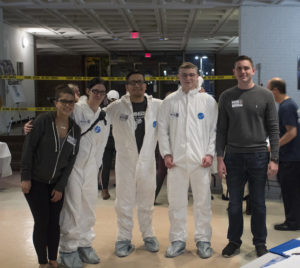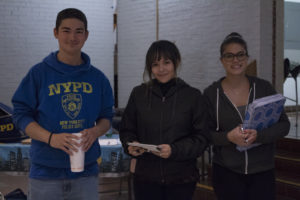-
CSI: Farmingdale
On Tuesday, November 06, 2018, Dr. David Byrne and the CRJ 201 Criminalistics students began their investigation on their Mock Crime Scene. Every semester the School of Arts & Criminal Justice Program presents a unique opportunity for its CRJ 201 Criminalistics students to use the knowledge they’ve obtained in class and put it to the test as they group together to focus on analyzing the evidence from their specific crime scene. I had the opportunity to join Dr. Byrne and his students, alongside helpful volunteers, to view students handling a crime scene as they would in a real life event.
Taking place in Sinclair hall, Students were split up into three groups; Blue, Black, and Grey. Each was assigned to a specific crime scene that was already set up by Dr. Byrne in order to be examined. Team captains were first to arrive and prepare materials in order to assure their team will not contaminate the crime scene in anyway. A principle they must remember is, the Locard Principle. The Locard Principle states, any time someone steps into an active crime scene they leave something, but also take something away. This is crucial to note as in any crime scene the students must ensure they disturb the evidence and environment around them as little as possible. Those who were assigned to step into the crime scene were required to wear coveralls and gloves to prevent any of their own DNA from disturbing the evidence being gathered; simulating a real world situation.
Dr. Byrnes made sure to set up the crime scenes to imitate an actual scene. Once each group arrived at their respective scene, they were informed on the background information based on 911 calls, witness reports, an illustration of the crime. From there it is up to the students to determine their first steps. Following procedures they learned in lecture, they are able to display their knowledge and understanding of handling the materials given. Group members were assigned to different tasks such as interviewer, patrol, and examiners. Each member must take responsibility of their role while continuously interacting with each other as they move through their investigation. Every team embraced their roles showcasing their skills throughout the event. While, some processed the scene and marked evidence, another interviewed passing witnesses connecting with them and securing as many claims as possible. With a patrol, who not only aided in the processing of the scene, but also secured the area as witnesses began to gather.
Each role is crucial to the process of the scene and every group member worked in conjunction to perform and use every skill taught. Having a chance to interview some students they were able to give me the synopsis of the crime scenes they were examining as well as taking me through the process of securing and processing the scene. It is truly fascinating to learn all the different techniques they were using and amazing how much the embraced the information taught from the lecture.
The overall event is presented as a hands-on experience which allowing each student to hone their skills and imprint them for later use. There is a noticeable impact that this event has as Dr. Byrne states, “A lot of times you take a test and regurgitate all the facts and then you leave there, blank slate. So here, it increases retention… by doing it you remember it.”
The event has helped many students and even the whole program as he finds that his students are able to hone in on these skills and embrace them as they embark on career paths. Many students find the enthusiasm to follow criminal justice taking this course and participating in this event. One of Dr. Byrne’s students is currently going for a position with a medical examiner. I wish her the best of luck and already know she will be fully prepared after taking this course.



